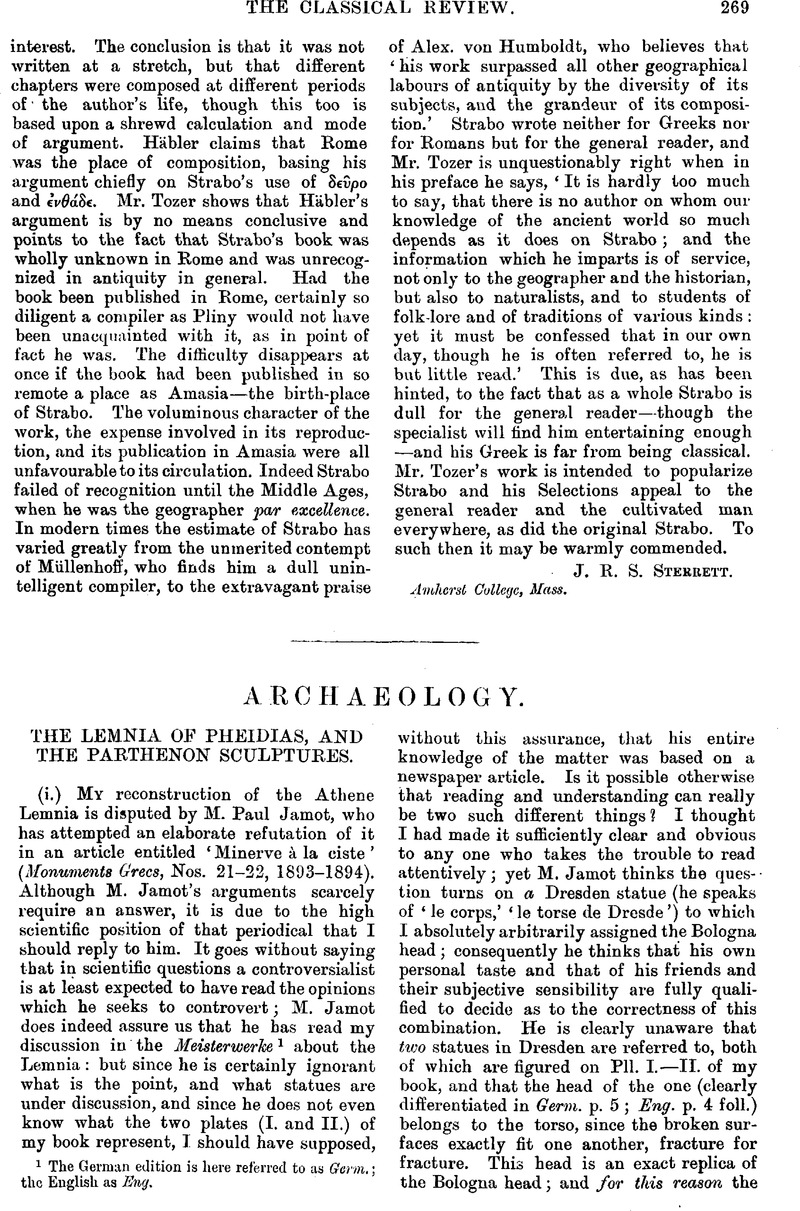No CrossRef data available.
Article contents
Archaeology
Published online by Cambridge University Press: 27 October 2009
Abstract

- Type
- Other
- Information
- Copyright
- Copyright © The Classical Association 1895
References
page 269 note 1 The German edition is here referred to as Germ.; the English as Eng.
page 270 note 1 E.g. the ‘Venus Genetrix’ and the ‘Demeter’ in Berlin, which is referred to Meisterw. p. 116. For the measurements of both statues see Kalkmann, Die Proportiorwn des Gesichts, pp. 92, 104.
page 271 note 1 Badly reproduced La Borde, Vases Lamberg, i. 34.
page 271 note 2 Omitted in the reproduction.
page 271 note 3 Brunn in his Catalogue wrongly doubts the antiquity of the reliefs 39 a–e; they are absolutely authentic.
page 272 note 1 Kekrops with his (laughters (not his wife) occurs also on the tapestry described in Euripides Ion 1163, which was a dedication by an Athenian.
page 273 note 1 Cf. Furtwängler, Satyr von Pergamon, p. 28.
page 273 note 2 As regards the type of the coins of Panticapaeum there discussed, I add that it is evidently borrowed from the Cyzicene type(Num. Chron. 1887, PI. 2, 18)
page 274 note 1 Arch. Anzeiger 1894, p. 181.
page 274 note 2 Especially clear is this in Inscr. ins. marts Aegaei i. 786, for τὰς στιβάδας κ∘σμεῐν can only be said of couches; ![]() i.e. near, before the altar.
i.e. near, before the altar.
page 275 note 1 The Andania inscription (Dittenberger, Syll. 388, 35) forbids this decoration of the tents, probably as too luxurious.
page 275 note 2 De Konchaud, Rev. Arch. 23, 249 gives an explanation which is evidently incorrect of the passages Odyssey 4, 124; 1, 130.
page 275 note 3 With the στρώματα a special attendant is sent to ὑπ∘στρωννὸεπ, which process the Hellenes cannot perform in the Persian manner : evidently therefore it is the preparation of the couch and not of the floor which is in question.
page 275 note 4 Brunn, Gesch. d. Künstler ii. 258, and Wickhoff, Wiener Genesis § 51 give an entirely wrong interpretation of the passage, as referring to carpets.
page 277 note 1 The cuts given above are from new tracings made by Mr. Anderson. Unfortunately, by an error in reduction, the two scenes are made to vary in height: though varying in length, they should of course be the same height.
page 278 note 1 Since writing this, I see that Robert, Bild und Lied, p. 211, has noticed the same similarity : ‘ …dem wirren Haar und dem struppigem Bart, dem wilden und trotzigem Aussehen, das so auffallig an den verbrecherischen Ixion der Ruckseite erinnert.’ He also points out that the figure on the right of a looks more like a priest.
page 278 note 2 From a similar motive Orestes, seated in suppliance at the omphalos, is represented holding up a sword: see Baumeister, p. 1117, fig. 1314.
page 279 note 2 At first sight the snake seems to suggest the Pythian serpent; but the animal which becomes later the ministrant of Apollo has primarily an underworld function.
page 280 note 1 Les Divinités de la Victoirc en Gréce et en Italic: Baudrillart, André. Paris, 1894Google Scholar. Reviewed by Miss Harrison in the Classical Review, April 1895.
page 281 note 1 Mythology and Monuments of Ancient Athens, 366.
page 281 note 2 Op. cit. pp. 1–2, 7, etc.
page 281 note 3 Theog. 383 ff.
page 281 note 4 p. 13.
page 281 note 5 Preller-Kobert, pp. 216, 494—496.
page 281 note 6 ‘Die Flügelgestalten der Athene und Nike auf Münzen,’ Huber's Numism. Zeitschr. 1871.
page 281 note 7 This theory is quoted with approval by Knapp, Nike in der Vasenmalerei: Tubingen, 1876.
page 281 note 8 Victory, on a coin of Himera (about 450 B. c.), holding aplustre bound with a fillet. ‘She seems connected with naval war rather than with the games.’ Gardner, (Types of Greek Coins: PI. II., No. 21).
page 281 note 9 Imhoof-Blumer, op. cit.
page 282 note 1 Paus. v. 14, 6.
page 282 note 2 The Scholiast says ![]() but Himerius at all events refers to the proper Nike, as is shown by χρνσ∘πτέρυγε.
but Himerius at all events refers to the proper Nike, as is shown by χρνσ∘πτέρυγε.
page 282 note 3 So the Schol. on Soph. Phil. 134.![]() .
.
page 282 note 4 Paus. i. 42, 3. Kekulé, Die Balustrade des Tempels der Athena Nike, p. 9.
page 282 note 5 Dittenberger, Syll. 370, 27. (An inscript. of the third cent. B.C.)
page 282 note 6 Gardner, Types of Greek Coins, PI. 1. 23. Head, Hist. Num. p. 96.
page 282 note 7 Op. cit. p. 114.
page 282 note 8 Op. cit. p. 108.
page 282 note 9 Knapp, p. 11. M. Mayer in Roscher's Lex. 354.
page 282 note 10 Mitchell, History of Ancient Sculpture, p. 195.
page 282 note 11 Schol. on Arist. Av. 574.
page 282 note 12 Sauer in Athen. Mitth. 1891, pt. 2.
page 282 note 13 s.v. ‘Iris,’354.
page 283 note 1 This was printed for a special purpose, but not published. I have therefore not hesitated to incorporate some small part of it in the present paper. I was indebted to Prof. Waldstein for the suggestion of the subject, and to Mr. E. Gardner and Dr. Sandys, among others, for much valuable assistance.
page 283 note 2 Harpocration, s.v. ![]()
page 283 note 3 Paus. v. 26, 6.
page 283 note 4 Ueber das Cultusbild der Athene Nike, Wien, 1879, p. 21.
page 283 note 5 Myth, and Mom. p. 366. So Stark, Philologus, 1860.
page 283 note 6 Furtwängler in Roscher's Lex. s.v. ‘Athene’ 689. He advocates a great antiquity for the cult of Athena Nike, but, it seems to me, on insufficient evidence.




